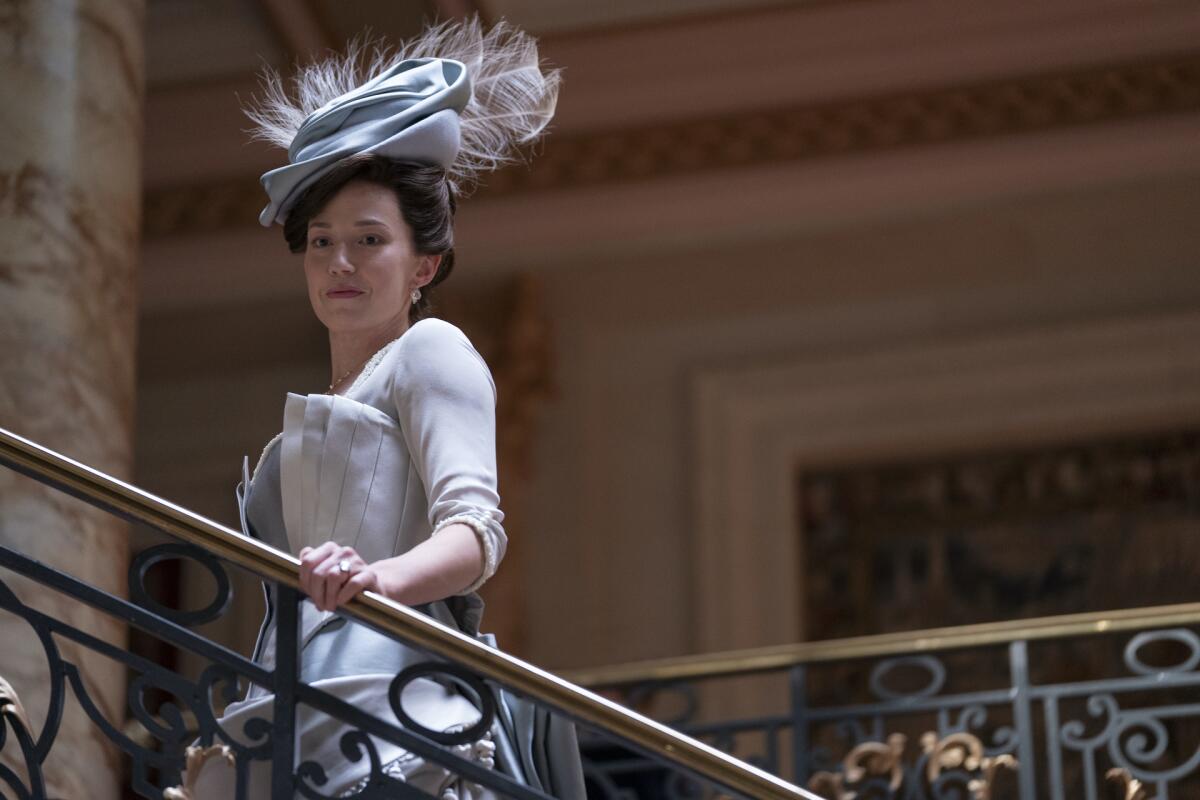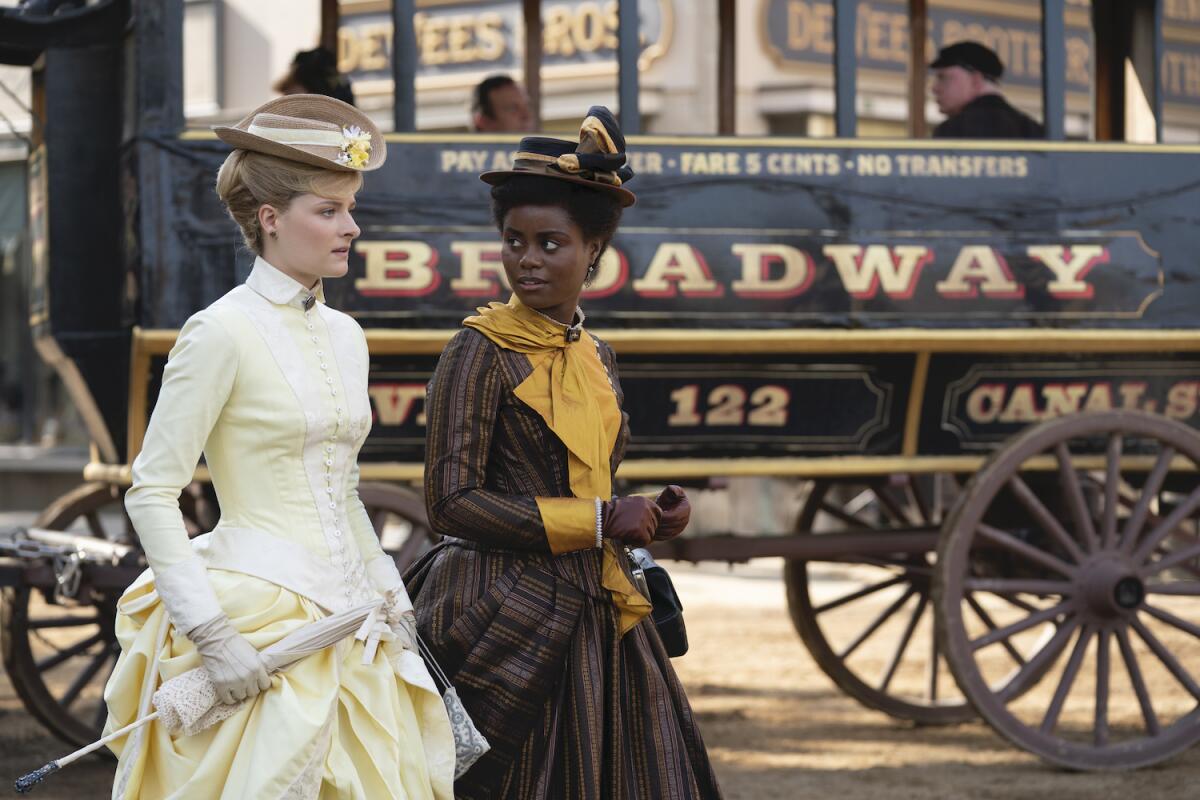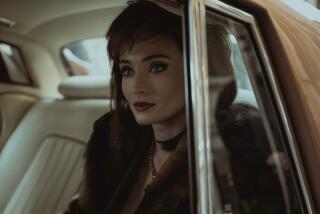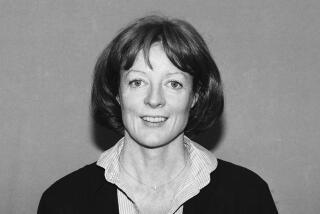How HBO’s dreary ‘Gilded Age’ fails the tumultuous era it depicts

In HBO’s “The Gilded Age,” Julian “Downton Abbey” Fellowes transfers his interest in rich people and the people who serve them from early 20th century England to late 19th century New York. Once again, it’s an upstairs-downstairs, extravagantly dressed soap opera set against a background of social change, as a self-styled aristocracy enamored of its own blood clashes with modernity, including a younger generation less interested in their parents’ way of doing things.
Louisa Jacobson (the third actress daughter of Meryl Streep) plays Marian, whom we meet in rural Pennsylvania, learning that all that’s left of her late father’s estate is $30. Having nowhere to live and nothing to live on, or any evident skills or prospects, she heads to New York City and the protection of her aunts Agnes (Christine Baranski) and Ada (Cynthia Nixon), from whom she has been estranged. (It’s like “Cold Comfort Farm” in reverse.) Setting off, her purse, money and tickets are stolen; she is lent train fare by Peggy Scott (Denée Benton), a Black woman from Brooklyn whose business in Doylestown, Pa., is left an undiscussed mystery through the five episodes (of nine) out for review.
The narrative convenience of a storm shutting down ferry service to Brooklyn, combined with Marian’s indebtedness and good soul and the fact that for some reason Peggy is loath to return to her parents’ house, brings them together to her aunts’ Fifth Avenue mansion. Here, having displayed excellent penmanship, knowledge of shorthand and an educational pedigree, Peggy — who wants to be a writer, like Jo in “Little Women” — becomes the secretary of Aunt Agnes, a widow whose riches, Agnes likes to point out to Ada, were “not achieved at no cost to myself,” while Ada was allowed to lead “the pure and tranquil life of a spinster.”
Across the way, at the corner of Fifth Avenue and 61st Street — much to the annoyance of Aunt Agnes but to the interest of Aunt Ada — the scaffolding is coming down on the just-completed mansion of the Russells, who represent “new people,” which is to say money. (“We only receive the old people in this house, not the new,” says Agnes, who is proud of her pre-Revolutionary roots.) George Russell (Morgan Spector), the very picture of a “robber baron,” if an unusually handsome one, is in railroads. The house, “big enough to be splendid without being oppressive” — and less ostentatious than some of the era’s actual Fifth Avenue mansions — is the closely overseen work of his wife, Bertha (Carrie Coon), and putatively designed by the historical Stanford White. Bertha hopes her home, if you can call it that, will be the portal through which she gains entrance to the city’s social inner circle.
The story of how “Downton Abbey” began, 10 years ago, is too familiar to need retelling here, so I’ll skip to the moment when Peter Fincham gave the green light and welcomed us to ITV.
Clearly, Fellowes has done research — indeed, it tends to lie on top of the story, like chocolate sprinkles, rather than being baked into the cake itself — but research doesn’t automatically translate into drama. For whatever combination of script, production, direction and performance, of mannerly expressions and dialogue that avoids contractions, “The Gilded Age” feels remarkably inert, even dreary, for a story set in America’s most exciting city in a period of turmoil. (There are plenty of documentaries and lectures on the era to be found online, many of which are more stimulating than this reconstruction.)
A smorgasbord of contemporary practices, mores and historical tidbits is duly served: political graft and stock manipulation; charity as a way to buy favor; croquet and badminton at Newport; fashionable French chef; tenement scene; Broadway pronounced with the accent on “way”; the question of whether the new opera house supported by the new people will displace the old people’s venerable Academy of Music — an issue, I note, raised in the second paragraph of Edith Wharton’s “The Age of Innocence.” (You can almost smell the yellow highlighter.) Indeed, there are times when “The Gilded Age” feels like fan service — to Martin Scorsese’s film of Wharton’s book. Real people from history include Black newspaper editor T. Thomas Fortune (Sullivan Jones), American Red Cross founder Clara Barton (Linda Emond); social gatekeeper Mrs. Astor (Donna Murphy), and her gatekeeper Ward McAllister (Nathan Lane), who came up with the whole awful notion of “the 400,” fancy people who would not be uncomfortable in one another’s presence.
If it is not quite fair to view “The Gilded Age” through the lens of “Downton Abbey,” it’s also difficult not to. (There are similarities as well to Fellowes’ more sprightly 2020 limited series “Belgravia,” based on his own novel, about the meeting of merchant and aristocratic classes in early 19th century London.) As a dispenser of arch commentary, throwing in her lot with a more genteel, ordered past — to which Fellowes, a Conservative member of the House of Lords, generally seems sympathetic — Aunt Agnes is very much the successor to Maggie Smith’s Dowager Countess in “Downton Abbey,” but less funny. Not that “The Gilded Age” has any sort of responsibility to be funny, but humor is part of what made “Downton Abbey” so watchable, and even when characters say things that are supposed to be witty, they often fall flat.
Another reason “Downton Abbey” worked so well is that it is a big show painted on a small canvas; various intrusions of history notwithstanding, it is parochial and provincial and intimate, like a Jane Austen novel, centered on a single family and its retainers. “The Gilded Age,” perhaps appropriately to the style of those times, is overcrowded — two houses, unalike in dignity, separated by an unpaved stretch of 61st Street, each with its family, relations and staff (neither has much in the way of friends). As a result, many of its storylines are rendered in shorthand, with characters who seem created more as historical bullet points — to express a type, or an opinion — than as fully fledged individuals.

Similarly, the relationship between Marian and Peggy, unusual enough within its historical context, might lead a viewer to wonder why it is not more commented upon. Racial matters are treated for the most part superficially or predictably, as when Peggy meets with the editor of a white publication, before the series passes on to other matters.
To be fair, Fellowes does attempt to give his main characters some breadth — something like two and a half dimensions. Aunt Agnes is old-fashioned but takes Peggy into her household without a second thought; she reserves her prejudice for the nouveau riche. Ada appears to be woolly-headed and childish, but she is also the series’ main voice of what a modern audience would consider wisdom, and the fact that one feels she is in constant danger of being hurt makes her easy to invest in emotionally. George Russell is professionally ruthless but a more relaxed parent than his wife, whom he loves, and whose social ambitions he indulges; Spector, with the look of a John Singer Sargent portrait having left its frame, plays him as a leading man.
As for Bertha, beyond her being rejected out of hand as a “potato digger’s daughter” and a little hurt by people whom she does not like but whose club she seeks to join, there is little sympathetic in her character; if not quite a villainess, she’s essentially without soul and often unpleasant, and although she’s one of the few figures here driven by an unrealized ambition, it’s difficult to care whether she attains it. (Will anyone come to the big ball Bertha throws to inaugurate her Fifth Avenue palace? You already know the answer.) “I’ll never give up! And I promise you this, I’ll make them sorry one day,” Bertha declares after a major disappointment, sounding a lot like Scarlett O’Hara on the steps of Tara.
For the record:
4:21 p.m. Jan. 25, 2022An earlier version of this review incorrectly gave actor Blake Ritson’s last name as Ruston
The clash of one class of wealthy snobs and another class of wealthy snobs hardly merits choosing a side, and many of the younger (and poorer) characters — including Agnes’ scheming son (Blake Ritson), the Russells’ daughter (Taissa Farmiga) and Bertha’s ambitious lady’s maid (Kelley Curran) — are simply not original or vibrant enough to involve us in their fates.
Marian, for her part, has been given few aspirations, other than “to be busy, to be needed, to be in a hurry.” “Unlike you,” she tells Peggy, “I don’t have any burning talent yearning to be free,” her phraseology miraculously anticipating by a year the composition of Emma Lazarus’ “The New Colossus,” later associated with the Statue of Liberty — whose torch-bearing hand, placed in Madison Square Park as a sort of a fundraising teaser, Marian will visit.
Epix’s “Belgravia,” from “Downton Abbey” creator Julian Fellowes, packs the earlier series’ costumed appeal into a neat six-episode package.
The main question surrounding her is whether she’ll accept the advances of Tom Raikes (Thomas Cocquerel), a lawyer from back home who turns up in New York, or whether something will get going with Larry Russell (Harry Richardson), the new-money rich kid across the street, whom she meets cute over a runaway dog. (Neither would be acceptable to Agnes.) This may be an accurate enough reflection of a woman in her time and place but it doesn’t much do for a heroine in a television drama.
Obviously, in a show this big and expensive there are performances and scenes that work. Simon Jones makes an impression as the aunts’ butler, as does Jeanne Tripplehorn as a woman even more frowned upon than Bertha. One passage in which Marian discovers she has been naive about Peggy’s home life is quite effective, and leads to a momentary rift between them; as with much else in the series, one wonders whether it will develop into anything, but it is lost in the ceaseless shuffle, like an individual in a New York crowd scene.
But whatever is or is not going on with the characters, the show is always nice to look at; there is always some hat or gown to please the eye, some specially constructed or authentically Victorian block of buildings to admire. (Troy, N.Y., provided much of the latter.) A view from New Jersey across the water toward Manhattan, with a storm rolling in, looks more painted than photographed — well, after all, it is — and is very beautiful.
With four episodes left unseen, it’s not impossible that things will shift into higher gear. There are hints of plots and secrets among the domestics. Though we will finally meet Peggy’s mother (Audra McDonald) and father (John Douglas Thompson), there are boxes still to open there. Bullet points might bloom into involving stories, worn plots twist in unexpected ways and things get, if not thrilling, at least interesting.
‘The Gilded Age’
Where: HBO
When: 9 p.m. Monday
Rating: TV-MA (may be unsuitable for children under the age of 17)
More to Read
The complete guide to home viewing
Get Screen Gab for everything about the TV shows and streaming movies everyone’s talking about.
You may occasionally receive promotional content from the Los Angeles Times.







